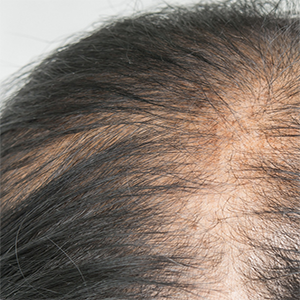Hair disorder in dr. Cipto Mangunkusumo cosmetic dermatology and venereology outpatient clinic of Jakarta, Indonesia: a socio-demographic and clinical evaluation

Accepted: 19 December 2021
HTML: 9
All claims expressed in this article are solely those of the authors and do not necessarily represent those of their affiliated organizations, or those of the publisher, the editors and the reviewers. Any product that may be evaluated in this article or claim that may be made by its manufacturer is not guaranteed or endorsed by the publisher.
Hair disorder has a significant impact on sociopsychology. In Indonesia, there are currently few and out-of-date studies on hair disorders. Our study aimed to provide an update on the epidemiology of hair loss, which is common in Indonesia. This is a retrospective study of hair disorder cases seen at Dr. Cipto Mangunkusumo’s Cosmetic Dermatology Outpatient Clinic at the National Central General Hospital from January 2017 to December 2019. Each patient’s age, gender, family history, education, occupation, body mass index (BMI), comorbidities, and diagnosis were recorded. Hair disorders were found to be more prevalent in males (54.6 percent) with a mean age of 26.41 ± 12.8 years old and the highest age group of 18-39 years old (59.4 percent) among the 64 patients who were eligible for the study. There were 32 cases (50.0%) of alopecia areata (AA), 20 cases (31.2%) of alopecia androgenetic (AGA), 9 cases (14.0%) of telogen effluvium (TE), 2 cases of cicatricial alopecia (CA) due to lupus erythematosus (DLE), and 1 case of trichotillomania (TTM). Female patients had significantly more TE cases. Cases of AGA in the study, mainly early-onset AGA (mean age 29.45 ± 10.29 years old, 39.5% in 18-39 years old) showed a significant positive familial history. At dr Cipto Mangunkusumo National General Hospital Jakarta, the most common types of hair disorders were AA, AGA, and TE, with each disease having a unique socio-demographic and clinical profile.
Hunt N, McHale S. The psychological impact of alopecia. BMJ 2005;331:951–3. DOI: https://doi.org/10.1136/bmj.331.7522.951
Alfani S, Antinone V, Mozzetta A, et al. Psychological status of patients with alopecia areata. Acta Derm Venereol. 2012;92:304–6. DOI: https://doi.org/10.2340/00015555-1239
N Yu, Tan H, Song Z, Yang X. Illness perception in patients with androgenetic alopecia and alopecia areata in China. J Psychos Res 2016;86:1–6. DOI: https://doi.org/10.1016/j.jpsychores.2016.04.005
Lolli F, Pallotti F, Rossi A, et al. Androgenetic alopecia: a review. Endocrine 2017;57:9-17.
Strazzulla L, Wang E, Avila L, et al. Alopecia areata: An appraisal of new treatment approaches and overview of current therapies. J Am Acad 2020;78-1:15-24. DOI: https://doi.org/10.1016/j.jaad.2017.04.1142
Vañó-Galván S, Saceda-Corralo D, Blume-Peytavi U, et al. Frequency of the Types of Alopecia at Twenty-Two Specialist Hair Clinics: A Multicenter Study. Skin Append Disord 2019;5:309-15. DOI: https://doi.org/10.1159/000496708
Falto-Aizpurua L, Choudhary S, Tosti A. Emerging treatments in alopecia. Expert Opin Emerg Drugs 2014;19:545–56.
Rexbye H, Petersen I, Iachina M, et al. Hair loss among elderly men: etiology and impact on perceived age, J. Gerontol A Biol Sci Med Sci 2005:60;1077–82. DOI: https://doi.org/10.1093/gerona/60.8.1077
Falto-Aizpurua L, Choudhary S, Tosti A. Emerging treatments in alopecia. Expert Opin Emerg Drugs 2014;19:545–56. DOI: https://doi.org/10.1517/14728214.2014.974550
Alfonso M, Richter-Appelt H, Tosti A, et al. The psychosocial impact of hair loss among men: a multinational European study. Curr Med Res Opin 2005;21:1829–36. DOI: https://doi.org/10.1185/030079905X61820
Gilhar A, Etzioni A, Paus A. Alopecia areata. N Engl J Med 2012;366:1515–25. DOI: https://doi.org/10.1056/NEJMra1103442
Legiawati L. Hair Loss and Baldness Cases in Clinic Dermatology an Venereology Clinic Dr. Cipto Mangunkusumo National General Hospital 2009-2011 [In Indonesian]. Med Dermato Venereol Indones 2013;40:159-63.
Pindado-Ortega C, Saceda-Corralo D, Buendía-Castaño D, et al. Prescribing Habits for Androgenic Alopecia among Dermatologists in Spain in 2017: A Cross-Sectional Study. Actas Dermosifiliogr 2018;109:536–42. DOI: https://doi.org/10.1016/j.adengl.2018.05.020
Indonesia Central Bureau of Statistics. Indonesia education picture: Education statistics [In Indonesian]. Jakarta: Indonesia Central Bureau of Statistics; 2020.
Kim BK, Lee S, Jun M, et al. Perception of Hair Loss and Education Increases the Treatment Willingness in Patients With Androgenetic Alopecica: A Population-Based Study. Ann Dermatol 2018;30:402-8. DOI: https://doi.org/10.5021/ad.2018.30.4.402
Strazzulla LC, Wang EHC, Avila L, et al. Alopecia areata: Disease characteristics, clinical evaluation, and new perspectives on pathogenesis. J Am Acad Dermatol 2018;78:1-12. DOI: https://doi.org/10.1016/j.jaad.2017.04.1141
Lee HH, Gwillim E, Patel KR, et al. Epidemiology of alopecia areata, ophiasis, totalis, and universalis: A systematic review and meta-analysis. J Am Acad Dermatol 2020;82:675-82. DOI: https://doi.org/10.1016/j.jaad.2019.08.032
McElwee KJ, Gilhar A, Tobin DJ, et al. What causes alopecia areata? Exp Dermatol 2013;22:609-26. DOI: https://doi.org/10.1111/exd.12209
Xuan L, Baohua Y, Lan B. Alopecia areata and vitiligo as primary presentations in a young male with human immunodeficiency virus. Indian J Dermatol 2014;59:209. DOI: https://doi.org/10.4103/0019-5154.127710
Blume-Peytavi U, Blumeyer A, Tosti A, et al. S1 guideline for diagnostic evaluation in androgenetic alopecia in men, women and adolescents. Br J Dermatol 2011;164:5–15. DOI: https://doi.org/10.1111/j.1365-2133.2010.10011.x
Ding Q, Xu YX, Sun WL, et al. Early-onset androgenetic alopecia in China: a descriptive study of a large outpatient cohort. J Int Med Res 2020;48:300060519897190.
Ding Q, Xu YX, Sun WL, et al. Early-onset androgenetic alopecia in China: a descriptive study of a large outpatient cohort. J Int Med Res 2020. DOI: https://doi.org/10.1177/0300060519897190
Yeo IK, Jang WS, Min PK, et al. An epidemiological study of androgenic alopecia in 3114 Korean patients. Clin Exp Dermatol 2014;39:25–9. DOI: https://doi.org/10.1111/ced.12229
Lolli F, Pallotti F, Rossi A, et al. Androgenetic alopecia: a review. Endocrine 2017;57:9–17. DOI: https://doi.org/10.1007/s12020-017-1280-y
Severi G, Sinclair R, Hopper JL, et al. Androgenetic alopecia in men aged 40-69 years: prevalence and risk factors. Br J Dermatol 2003;149:1207-13. DOI: https://doi.org/10.1111/j.1365-2133.2003.05565.x
Fatani MI, Bin Mahfoz AM, Mahdi AH, et al. Prevalence and factors associated with telogen effluvium in adult females at Makkah region, Saudi Arabia: A retrospective study. J Dermatol Surg 2015;19:27-30. DOI: https://doi.org/10.1016/j.jdds.2014.04.002
Copyright (c) 2022 the Author(s)

This work is licensed under a Creative Commons Attribution-NonCommercial 4.0 International License.
PAGEPress has chosen to apply the Creative Commons Attribution NonCommercial 4.0 International License (CC BY-NC 4.0) to all manuscripts to be published.





 https://doi.org/10.4081/dr.2022.9341
https://doi.org/10.4081/dr.2022.9341



